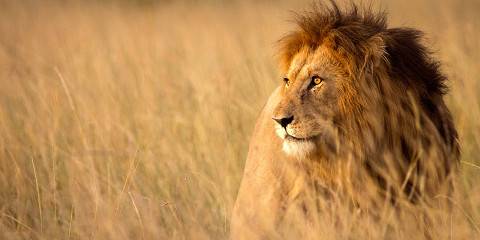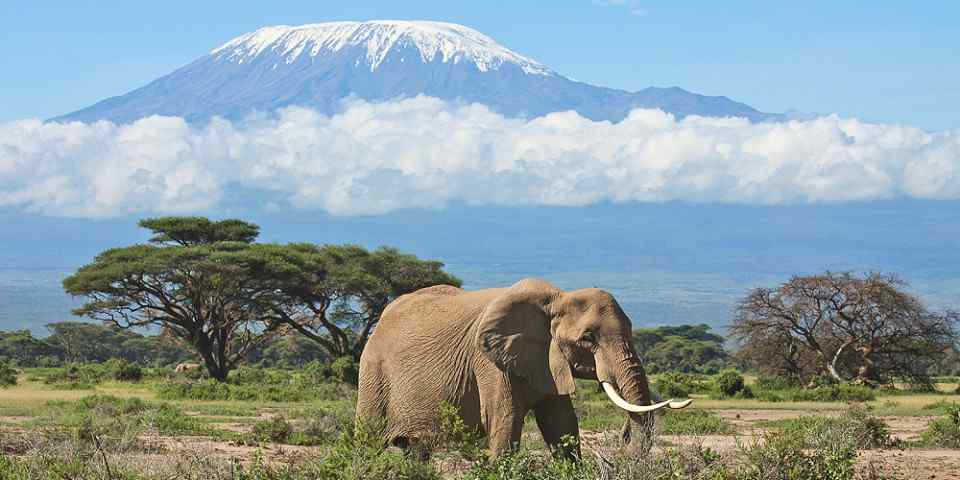Tour Length
Rates in USD $ – Change Currency
Per person, excl. international flightsOperator Rating
Other Tour Features
Filter by Operator
Filter by Accommodation
Amboseli Safari Tours & Holidays
Amboseli National Park is one of East Africa’s most rewarding safari destinations, and a real classic of the Kenya safari circuit. Compact enough to get around easily, filled with wildlife, replete with good accommodation in and around the park, and with the best Kilimanjaro views to be had anywhere on the continent, Amboseli should be on the list of every safari visitor to Kenya. It’s also close to Nairobi, making it easy to visit in a short time frame, and combine it with other parks as well.
-

5-Day Masai Mara-Lake Naivasha- Amboseli Safari
$1,309 to $1,463 pp (USD)
Kenya: Private tour
Mid-range Lodge & Tented CampYou Visit: Nairobi (Start), Masai Mara NR, Lake Naivasha (Naivasha), Amboseli NP, Nairobi (End)

Beacon Safaris
4.9/5 – 311 Reviews
-
Best Seller

7-Day Amboseli, Naivasha, Lake Nakuru, Masai Mara Safari
$2,365 to $2,475 pp (USD)
Kenya: Private tour
Mid-range Lodge & Tented CampYou Visit: Nairobi (Start), Amboseli NP, Lake Naivasha (Naivasha), Lake Nakuru NP, Masai Mara NR, Nairobi (End)

Leopard Orchid Safaris
5.0/5 – 56 Reviews
-

14-Day Kenya Wildlife Safari & Beach Holiday
$4,681 to $6,534 pp (USD)
Kenya: Private tourLuxuryLodge & Tented Camp
You Visit: Nairobi (Start), Ol Pejeta Conservancy (Laikipia Plateau), Lake Nakuru NP, Masai Mara NR, Lake Naivasha (Naivasha), Amboseli NP, Tsavo West NP, Diani Beach, Nairobi (End)

Tekko Tours and Travel
4.9/5 – 139 Reviews
-

7-Day Living Among the Elephants
$1,007 to $1,227 pp (USD)
Kenya: Shared tour (max 7 people per vehicle)BudgetTented Camp & Hotel
You Visit: Nairobi (Start), Masai Mara NR, Lake Nakuru NP, Hell’s Gate NP, Amboseli NP, Amboseli NP, Nairobi (End)

Sunstrip Africa Safaris
4.5/5 – 38 Reviews
-
![7-Day Magical Kenya Luxury Safari]()
7-Day Magical Kenya Luxury Safari
$3,674 to $4,370 pp (USD)
Kenya: Private tourLuxuryLodge & Tented Camp
You Visit: Nairobi (Start), Amboseli NP, Lake Naivasha (Naivasha), Lake Nakuru NP, Masai Mara NR, Nairobi (End)

Estleon Adventures
5.0/5 – 134 Reviews
-
![5-Day Budget Safari Amboseli, Lake Nakuru & Masai Mara]()
5-Day Budget Safari Amboseli, Lake Nakuru & Masai Mara
$1,205 pp (USD)
Kenya: Private tourBudgetTented Camp & Hotel
You Visit: Nairobi (Start), Amboseli NP, Lake Nakuru NP, Masai Mara NR, Nairobi Airport (End)

Johnbow Tours and Travel
4.8/5 – 27 Reviews
-
![8-Day Kenya Safari Masai Mara Nakuru Naivasha Amboseli]()
8-Day Kenya Safari Masai Mara Nakuru Naivasha Amboseli
$990 to $1,320 pp (USD)
Kenya: Shared tour (max 7 people per vehicle)BudgetTented Camp & Hotel
You Visit: Nairobi (Start), Masai Mara NR, Lake Nakuru NP, Lake Naivasha (Naivasha), Amboseli NP, Nairobi (End)

Bienvenido Kenya Tours and Safaris
4.7/5 – 124 Reviews
-
Best Seller
![7-Day Group Joining Wildlife Exploration]()
7-Day Group Joining Wildlife Exploration
$2,626 to $3,191 pp (USD)
Kenya: Shared tour (max 7 people per vehicle)
Mid-range Lodge & Tented CampYou Visit: Nairobi (Start), Masai Mara NR, Lake Nakuru NP, Lake Naivasha (Naivasha), Amboseli NP, Nairobi (End)

Jamlan Holiday Safaris
4.8/5 – 35 Reviews
-
![6-Day Stunning Adventure]()
6-Day Stunning Adventure
$2,569 to $3,357 pp (USD)
Kenya: Private tourLuxuryLodge & Tented Camp
You Visit: Nairobi (Start), Masai Mara NR, Lake Nakuru NP, Amboseli NP, Nairobi (End)

Rochar Africa Expeditions
4.9/5 – 25 Reviews
-
![8-Day Ultimate Kenya Luxury Safari]()
8-Day Ultimate Kenya Luxury Safari
$3,281 to $4,745 pp (USD)
Kenya: Private tourLuxuryLodge & Tented Camp
You Visit: Nairobi (Start), Amboseli NP, Lake Naivasha (Naivasha), Lake Nakuru NP, Masai Mara NR, Nairobi (End)

Splendid Vacations
4.9/5 – 57 Reviews
-
![7-Day Mara-Nakuru-Naivasha-Amboseli Budget Safari2025-26]()
7-Day Mara-Nakuru-Naivasha-Amboseli Budget Safari2025-26
$871 to $1,069 pp (USD)
Kenya: Shared tour (max 7 people per vehicle)BudgetTented Camp & Hotel
You Visit: Nairobi (Start), Masai Mara NR, Lake Nakuru NP, Hell’s Gate NP, Amboseli NP, Nairobi (End)

Pavillion Safaris and Tours
5.0/5 – 42 Reviews
-
![6-Day Luxury Classic Safari]()
6-Day Luxury Classic Safari
$2,640 pp (USD)
Kenya: Private tour
Mid-range Lodge & Tented CampYou Visit: Nairobi (Start), Amboseli NP, Lake Nakuru NP, Masai Mara NR, Jomo Kenyatta Airport (End)

Mara Triangle Safaris
5.0/5 – 30 Reviews
-
![7-Day Explore Kenya Budget Group Joining Safari]()
7-Day Explore Kenya Budget Group Joining Safari
$864 to $1,062 pp (USD)
Kenya: Shared tour (max 8 people per vehicle)BudgetTented Camp & Hotel
You Visit: Nairobi (Start), Masai Mara NR, Lake Nakuru NP, Hell’s Gate NP, Amboseli NP, Nairobi (End)

Dosasha Tours and Safaris
5.0/5 – 46 Reviews
-
![7-Day Amboseli Lake Nakuru and Maasai Mara 2025]()
7-Day Amboseli Lake Nakuru and Maasai Mara 2025
$1,815 to $2,558 pp (USD)
Kenya: Private tour
Mid-range Camping & Tented CampYou Visit: Nairobi (Start), Masai Mara NR, Lake Nakuru NP, Amboseli NP, Nairobi (End)

Back of Africa Adventure
5.0/5 – 85 Reviews
-
![4-Day Tsavo East, West and Amboseli Tour from Nairobi]()
4-Day Tsavo East, West and Amboseli Tour from Nairobi
$1,298 to $1,557 pp (USD)
Kenya: Private tour
Mid-range LodgeYou Visit: Nairobi (Start), Tsavo East NP, Amboseli NP, Nairobi (End)

Trav-Interactive
4.9/5 – 52 Reviews
-
![5-Day Tsavo East & West, Amboseli from Mombasa / Nairobi]()
5-Day Tsavo East & West, Amboseli from Mombasa / Nairobi
$2,409 pp (USD)
Kenya: Private tourBudgetLodge & Tented Camp
You Visit: Mombasa (Start), Tsavo East NP, Tsavo West NP, Amboseli NP, Nairobi (End)

Valley Rocks Tours
5.0/5 – 6 Reviews
-
![8-Day Grand Circuit - Mara, Nakuru, Naivasha & Amboseli]()
8-Day Grand Circuit - Mara, Nakuru, Naivasha & Amboseli
$3,245 to $4,697 pp (USD)
Kenya: Private tour
Mid-range Lodge & Tented CampYou Visit: Nairobi (Start), Masai Mara NR, Lake Nakuru NP, Lake Naivasha (Naivasha), Amboseli NP, Nairobi (End)

Moran Trails Adventures
5.0/5 – 3 Reviews
-
![3-Day Amboseli Budget Safari Excursion]()
3-Day Amboseli Budget Safari Excursion
$821 pp (USD)
Kenya: Private tourBudgetTented Camp
You Visit: Nairobi (Start), Amboseli NP, Nairobi (End)

Good Secrets Safaris
5.0/5 – 1 Reviews
-
![8-Day Masai Mara–Lake Nakuru-Lake Naivasha-Amboseli]()
8-Day Masai Mara–Lake Nakuru-Lake Naivasha-Amboseli
$1,320 to $1,650 pp (USD)
Kenya: Shared tour (max 8 people per vehicle)BudgetTented Camp & Hotel
You Visit: Nairobi (Start), Masai Mara NR, Lake Nakuru NP, Lake Naivasha (Naivasha), Amboseli NP, Nairobi (End)

Tropical Wild Expeditions
4.9/5 – 32 Reviews
-
![8-Day Amboseli, Masai Mara, Lake Nakuru & Mombasa]()
8-Day Amboseli, Masai Mara, Lake Nakuru & Mombasa
$1,320 to $1,386 pp (USD)
Kenya: Shared tour (max 7 people per vehicle)BudgetTented Camp & Resort
You Visit: Nairobi (Start), Masai Mara NR, Lake Nakuru NP, Amboseli NP, Mombasa Beaches, Haller Park (Highlight), Nairobi (End)

Eta Adventure Safaris
4.8/5 – 32 Reviews
8 Questions About Amboseli Safaris

Answered by
Anthony Ham
Anthony has been covering Amboseli for more than a decade as one of the writers of Lonely Planet’s guide to Kenya. He has also written extensively about the park, especially its lions and elephants, for both travel and conservation publications.› More about Anthony
8 Questions About Amboseli Safaris
 Anthony Ham
Anthony Ham
When is the best time to go on an Amboseli safari?
“June to October: this is the Dry season proper and, as for so many parks and reserves you’re likely to visit on your Kenya tour, it’s the perfect time for Amboseli safaris for that familiar combination of clear skies, dry safari trails and wildlife gathering around a shrinking number of waterholes. June could be my favorite month, with, for the most part, low- or shoulder-season prices. October is good for finding wildlife, but can also be fiercely hot. The short rains beginning in late October and/or November leave a lovely green tinge to the land through December, January and February; these latter two months can also be excellent for wildlife viewing. As a general rule, avoid March, April and, to a lesser extent, May, when the long rains can turn many trails into quagmires and most of the wildlife disperses beyond the park’s boundaries. Easter can also be overwhelming, with epic crowds of expats and locals flooding in from Nairobi and Mombasa.”
› More about the best time to visit Amboseli 1What are the best reasons to visit Amboseli?
“The wildlife is outstanding, but it’s given an added sense of grandeur by the killer Kilimanjaro views. It is almost the signature image of the African safari – an elephant grazing in the greener-than-green swamp grasslands in the center of the park with perfectly proportioned Mt Kilimanjaro behind. Africa’s highest mountain may lie in Tanzania, but easily the best views of the mountain are from Amboseli, especially in the early morning and late afternoon. Normatior, otherwise known as Observation Hill, is one of very few places where you can get out and stretch your legs, and also take in wonderful views in every direction. Elephants are everywhere in Amboseli, with big tusks and an untroubled demeanor – the elephants here have been studied at length by legendary scientist Dr Cynthia Moss for decades and they’re well accustomed to vehicles. There’s plenty of other wildlife, too, and the long sight lines make for more iconic African views – the savannah plains with acacia, the endless horizon, a silhouetted giraffe …”
2Can you visit Mt Kilimanjaro from Amboseli?
“No. The grand old mountain may look so close that you can reach out and touch it, and the Kenya–Tanzania border is not far away (somewhere close to the lower foothills of the mountain), but there’s no crossing here. The nearest crossing if you wish to actually climb the mountain is east of here, at Oloitokitok, a busy Maasai border town with an immigration post. All told, you can expect to drive for half a day, including time spent at the border, from Amboseli to Marangu, one of the gateway towns to a Kili climb, or on to Moshi where many of the climbing tour operators have their base.”
3What animals can I expect to see on an Amboseli safari?
“Elephants are easily the main draw of any Amboseli safari – they’re big, they’re beautiful and they’re always found in the Enkongo Narok, Ol Okenya and Longinye swamps that lie in the park’s heart. Bad-tempered hippos also lurk in the waters, occasionally emerging to do battle for territory. I’ve always been really fortunate on Amboseli tours with lions, cheetahs and spotted hyenas (including a den), while giraffe are often sighted amid the acacias in the park’s east. Other plains animals include zebras and Thomson’s gazelle in abundance, while baboons and vervet monkeys are similarly prolific. The swamps draw hundreds of bird species, especially waders, year-round but with a discernible spike in numbers from November when migrating species arrive from Europe.”
› More about the wildlife of Amboseli National Park 4How long is the drive to Amboseli?
“From Nairobi, it’s around a four-hour drive, although traffic levels along the Nairobi–Mombasa highway vary greatly. The most commonly used park gates are Iremito and Kimana. It’s also possible to drive from the Kenya–Tanzania border at Namanga, although you’ll need a 4WD vehicle for this route along the rough tracks of the park’s western reaches. There are a number of airstrips in the Amboseli Basin, and flying is a good alternative to the road journey. You can arrive for Amboseli tours in an hour from the capital’s Wilson Airport, through which there are connections to other Kenyan safari destinations, such as the Masai Mara or Samburu National Reserves.”
5What condition are the roads in within the park?
“Although I always prefer to travel in a 4WD vehicle, most Amboseli safari tour trails (with the possible exception of the western sector of the park) are accessible in a normal 2WD vehicle. Indeed, the most commonly sighted safari vehicle in Amboseli is the ubiquitous white minivan with a pop-up roof. I have seen minivans crossing the park with ease in April (the heart of the rainy season), but Amboseli’s poor soils quickly turn to mush after rains and only an experienced local driver should consider visiting the park in a 2WD at this time. There are, of course, no paved roads in Amboseli.”
6What are the pros and cons of different accommodation types?
“With Amboseli safari packages, the question is whether to stay inside the park or just beyond its boundaries. In the center of the park, there are two long-established but extremely comfortable lodges, a luxury tented camp and campsites, meaning a range of Amboseli safari prices. Whichever you choose, the advantage is that you don’t have to wait until the park gates open at 6 AM before exploring the heart of the park. It also means you can linger a little longer as the sun nears the horizon – it’s forbidden to drive inside the park after sunset. Staying outside the park means you’ll have more choice, from campsites, lodges and tented camps to luxury options on nearby Maasai lands. You may also save a little money on park entry fees, although not necessarily.”
7What lodges or camps would you recommend?
“Inside the park, I’ve always had a soft spot for the aging Amboseli Serena Safari Lodge, a sturdy structure and the first safari lodge I ever stayed in, while Ol Tukai Lodge has a fabulous location and rather lovely grounds. Elewana Tortilis Camp Amboseli is an elegant and nicely secluded luxury tented camp away from the busier areas of the park but still with fantastic Kilimanjaro views. Beyond the park, three places rank among the most storied and luxurious of Kenya safari accommodation options, and all three boast Kilimanjaro views. Tawi Lodge, on its own private conservancy east of Amboseli’s Kimana gate, is a terrific option with stunning accommodations, service and public areas. Ol Donyo Lodge, out beyond Mbirikani northeast of the park, is one of the most beautiful lodges I’ve stayed in while on a Kenya tour, while Campi ya Kanzi, away to the east off a trail to Tsavo West National Park, has a real Maasai feel to it and is a beautiful tented camp.”
8Amboseli Safari Reviews

Lizzie is a reputed guidebook writer and author of the Footprint guides to South Africa, Namibia, Kenya, Tanzania, Uganda and Zimbabwe.
Guaranteed Wildlife-Viewing at the Foot of Kilimanjaro
Amboseli has instant likeability and although it can be crowded with game-viewing vehicles, there are plenty of good reasons for its popularity. For a start, it’s a straightforward drive from Nairobi via the A109 and C102 roads. Once...
 US
US
Amazing experience in every one of these Parks/reserves. Every location was different and unique in its own ways. Saw the Big 5 due to the extensive itinerary, great coordination by Best Memory Safaris (Isaac) and saw many animals due to a...
 NO
NO
We stayed at Manjaro Tented Camps. This is highly recommended and basically did our whole stay here. Otherwise being close to Kilimanjaro is great, but it's very dry and not very beautiful otherwise. Looots of elephants, which was cool.
Amboseli is stunningly beautiful and very different from other national parks. We witnessed the predators and prey animals returning after the rains. Seeing Mount Kilimanjaro is wonderful. This was my third visit and I will go again next...
 LK
LK
Amboseli National Park is an outstanding safari destination, offering stunning views of Mount Kilimanjaro, abundant wildlife including large elephant herds, and diverse ecosystems. Its unique landscape and excellent game viewing...

































